Algorithms required for data structures(basics like Arrays, Stacks ,Linked Lists etc)
- 1. Algorithms
- 2. Definition An algorithm is any well-defined computational procedure that takes some values or set of values as input and produces some values or set of values as output
- 3. Definition A sequence of computational steps that transforms the input into output
- 4. 4 Algorithms Properties of algorithms: • Input from a specified set, • Output from a specified set (solution), • Definiteness of every step in the computation, • Correctness of output for every possible input, • Finiteness of the number of calculation steps, • Effectiveness of each calculation step and • Generality for a class of problems.
- 5. ? Suppose computers were infinitely fast and computer memory are free Is there any reason to study algorithm ? Yes – Demonstrate that solution methods terminates and does so with correct answer.
- 6. In reality • Computers may be fast, but they are not infinitely fast and • Memory may be cheap but it is not free • Computing time is therefore a bounded resource and so is the space in memory
- 7. 7 Complexity In general, we are not so much interested in the time and space complexity for small inputs. For example, while the difference in time complexity between linear and binary search is meaningless for a sequence with n=10, it is gigantic for n=230.
- 8. 8 Complexity For example, let us assume two algorithms A and B that solve the same class of problems. The time complexity of A is 5000n, the one for B is 1.1n for an input with n elements. For n = 10, A requires 50,000 steps, but B only 3, so B seems to be superior to A. For n = 1000, however, A requires 50,00,000 steps, while B requires 2.5x1041 steps.
- 9. 9 Complexity Comparison: time complexity of algorithms A and B Algorithm A Algorithm BInput Size n 10 100 1,000 1,000,000 5,000n 50,000 5,00,000 50,00,000 5x109 1.1n 3 2.5x1041 13,781 4.8x1041392
- 10. 10 Complexity • This means that algorithm B cannot be used for large inputs, while algorithm A is still feasible. • So what is important is the growth of the complexity functions. • The growth of time and space complexity with increasing input size n is a suitable measure for the comparison of algorithms.
- 11. Asymptotic Efficiency Algorithm • When the input size is large enough so that the rate of growth/order of growth of the running time is relevant. • That is we are concerned with how the running time of an algorithm increases as the size of the input increases without bound. • Usually, an algorithm that is asymptotically more efficient will be the best choice. 11
- 12. Asymptotic Notation The notations we use to describe the asymptotic running time of an algorithm are defined in terms of functions whose domains are the set of natural numbers N = {0, 1, 2,…. } 12
- 13. 13 Asymptotic Notation Let f(n) and g(n) be two positive functions, representing the number of basic calculations (operations, instructions) that an algorithm takes (or the number of memory words an algorithm needs).
- 14. Asymptotic Notation Q - Big Theta O – Big O W - Big Omega o – Small o w - Small Omega 14
- 15. 15 O-Notation For a given function g(n) O(g(n)) = {f(n) : there exist positive constants c and n0 such that 0 f(n) c. g(n) for all n n0 } Intuitively: Set of all functions whose rate of growth is the same as or lower than that of c. g(n)
- 16. O-Notation 16 g(n) is an asymptotic upper bound for f(n). f(n) = O(g(n)).
- 17. Example O(g(n)) = {f(n) : there exist positive constants c and n0 such that 0 f(n) c g(n) for all n n0 } f(n) = 5n+2 0 5n+2 6n n=0 020 (no) n=1 076 (no) n=2 01212 (yes) n=3 01718 (yes) 17 So n0=2, c=6, g(n)=n f(n)= O(n)
- 18. 18 Big-O Notation (Examples) • f(n) = 5n+2 = O(n) • f(n)=n/2 –3 0 n/2 –3 n/2; n0=6; c=1/2; f(n)=O(n) • f(n) = n2-n 0 n2–n n2; n0=0; c=1; f(n)=O(n2) • f(n) = n(n+1)/2 = O(n2)
- 19. W - Notation For a given function g(n) W(g(n)) = {f(n) : there exist positive constants c and n0 such that 0 c g(n) f(n) for all n n0} 19 Intuitively: Set of all functions whose rate of growth is the same as or higher than that of c.g(n).
- 20. W - Notation 20 g(n) is an asymptotic lower bound for f(n). f(n) = W(g(n)).
- 21. Example W(g(n)) = {f(n) : there exist positive constants c and n0 such that 0 c g(n) f(n) for all n n0} f(n) = 5n+2 0 5n 5n+2 n=0 002 (yes) n=1 057 (yes) n=2 01012 (yes) 21 So n0=0, c=5, g(n)=n f(n)= W(n)
- 22. Q - Notation For a given function g(n), Q(g(n)) = {f(n) : there exist positive constants c1 , c2 , and n0 such that 0 c1 g(n) f(n) c2 g(n) for all n n0 f(n) Q(g(n)) f(n) = Q(g(n)) 22
- 23. Q - Notation 23 g(n) is an asymptotically tight bound for f(n). f(n) and g(n) are nonnegative, for large n.
- 24. Example Q(g(n)) = {f(n) : positive constants c1, c2, and n0, such that n n0, 0 c1g(n) f(n) c2g(n) } • 5n+2 = Q(n) Determine the positive constant n0, c1, and c2 such that the above conditions satisfies 5n 5n+2 6n 24
- 25. Example Contd ... 5n 5n+2 is true for all n 0 5n+2 6n is true for all n2 5n 5n+2 6n is true for all n2 c1=5, c2=6, n0=2, g(n)=n f(n)= Q(g(n)) = Q(n) 25
- 26. Relations Between Q, O, W For any two function f(n) and g(n), we have f(n) = Q(g(n)) if and only if f(n) = O(g(n)) and f(n) = W(g(n)) That is Q(g(n)) = O(g(n)) W(g(n)) 26
- 27. Relations Between Q, O, W 27
- 28. 28 The Growth of Functions “Popular” functions g(n) are n.log n, 1, 2n, n2, n!, n, n3, log n Listed from slowest to fastest growth: • 1 • log n • n • n log n • n2 • n3 • 2n • n!
- 29. Comparing Growth Rates Problem Size T(n) log2 n n n log2 n n22n
- 30. Example: Find sum of array elements Input size: n (number of array elements) Total number of steps: 2n + 3 = f(n) Algorithm arraySum (A, n) Input array A of n integers Output Sum of elements of A # operations sum 0 1 for i 0 to n 1 do n+1 sum sum + A [i] n return sum 1
- 31. Algorithm arrayMax(A, n) Input array A of n integers Output maximum element of A # operations currentMax A[0] 1 for i 1 to n 1 do n if A [i] currentMax then n -1 currentMax A [i] n -1 return currentMax 1 Example: Find max element of an array Input size: n (number of array elements) Total number of steps: f(n)=3n






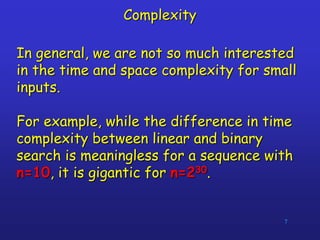




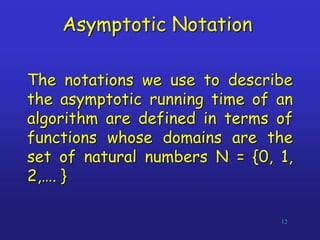


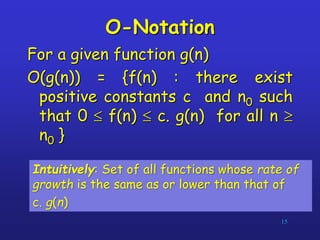
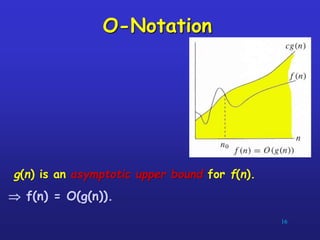
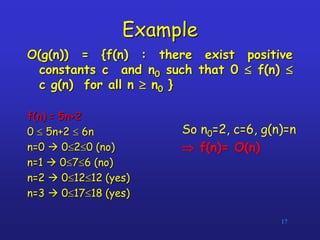

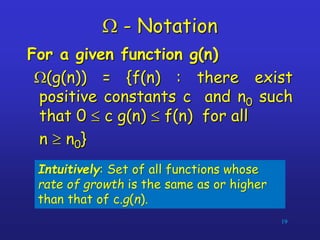

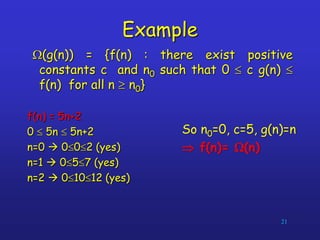
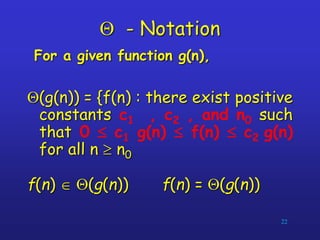
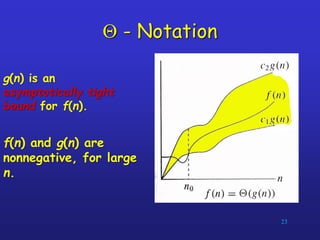






![Example: Find sum of array elements
Input size: n (number of array elements)
Total number of steps: 2n + 3 = f(n)
Algorithm arraySum (A, n)
Input array A of n integers
Output Sum of elements of A # operations
sum 0 1
for i 0 to n 1 do n+1
sum sum + A [i] n
return sum 1](https://image.slidesharecdn.com/2algorithim-200210195727/85/Algorithms-required-for-data-structures-basics-like-Arrays-Stacks-Linked-Lists-etc-30-320.jpg)
![Algorithm arrayMax(A, n)
Input array A of n integers
Output maximum element of A # operations
currentMax A[0] 1
for i 1 to n 1 do n
if A [i] currentMax then n -1
currentMax A [i] n -1
return currentMax 1
Example: Find max element of an
array
Input size: n (number of array elements)
Total number of steps: f(n)=3n](https://image.slidesharecdn.com/2algorithim-200210195727/85/Algorithms-required-for-data-structures-basics-like-Arrays-Stacks-Linked-Lists-etc-31-320.jpg)